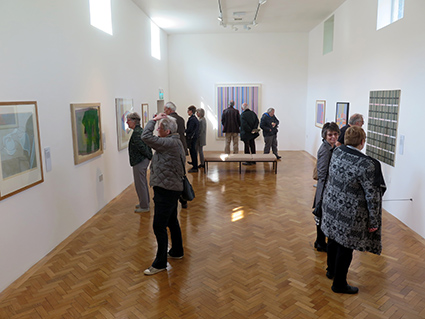Abstract art has been with us now for more than a century but, compared to figurative art, we have often found it hard to understand and difficult to approach. It is the apparent divorce between the forms, lines and colours of abstract art and any reference point in our real world that seems to trouble us. Yet historically, seemingly abstract works by artists from Kandinsky and Mondrian to Bridget Riley and Howard Hodgkin often have a clear underpinning referent in the real world, frequently landscape. Indeed many of their titles make this very clear. This exhibition in the Fermoy Gallery, part of the King’s Lynn mini-festival tackles this complex issue head on.
Again, curated meticulously by Rosy Gray, this is the second in her series of three exhibitions in which she explores aspects of ‘place’ by using carefully selected works from the Norwich Castle Museum’s extensive but seldom seen collection of contemporary art of which she is currently the guardian. This is a rich vein to mine and this second exhibition focuses on the many seemingly abstract works by major 20th century artists that in fact have their deep roots in landscape, connecting interestingly with the original core of the Castle’s collections, its huge holding of paintings from the Norwich school of painters.
Starting with works that have a slightly more overtly stated basis in figuration such as Undulating Valley by Anthony Gross, the series works its way round looser and looser connections to real places, through mythical or imaginary landscapes, and finishes with an explicitly non-figurative work by Ben Nicholson that nevertheless has the same ‘feel’ as many of its neighbouring works. There are some real gems here, only some of which, like the vast Bridget Riley, have ever been brought out into the light. The large and early 26.7.74 No.314 by Sean Scully is a revelation (currently, in Sea Star, his National Gallery exhibition, he is influenced by Turner). His severe rectangular grid riffs on US city plans and property boundaries, but also on the small fields of his Irish heritage, also separated by sharp ownership boundaries.
The undervalued Roy Turner Durrant has a beautiful work here, Autumn at Alderworth 1971, an abstract work, almost a Nicholson look-alike, but with subtle shades of a real autumn, experienced and reworked so delicately. And the revelation for me was Gulf of Corinth 1982 by Marjorie Wales. This work, sensibly used as the show’s poster image, reimagines from a family holiday, both the forms and colours of a view in central Greece and the feelings that it engendered. Still relatively unknown, Wales taught, together with her husband Geoffrey, at what is now Norwich University of the Arts and produced only a small body of finished work. So, while the Castle is lucky to have this small masterpiece, we are lucky to have the opportunity to view it now.

